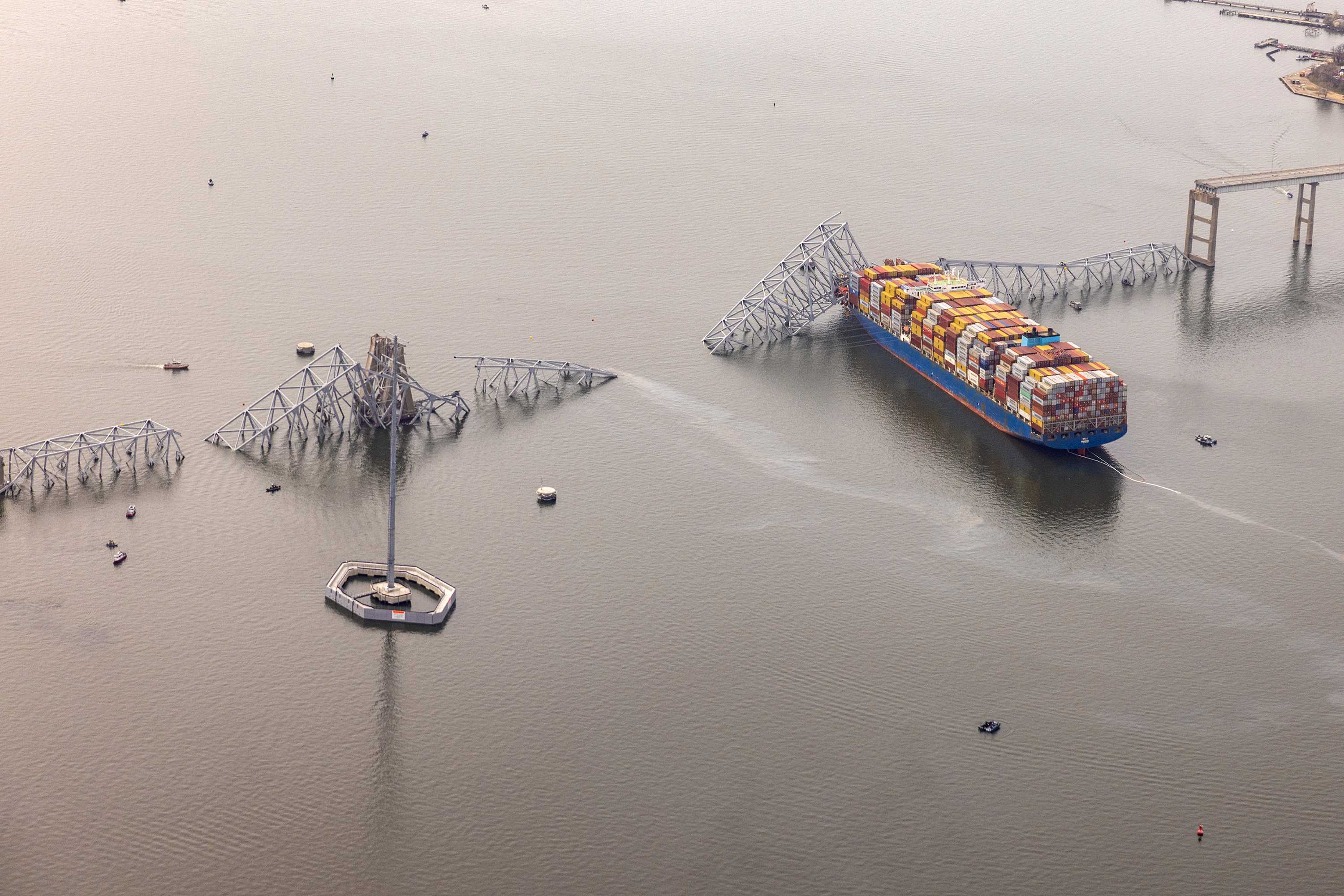Here’s what you should know about the Key Bridge collapse
From CNN staff

Officials recovered the bodies of two construction workers who were on Baltimore’s Francis Scott Key Bridge when it collapsed early Tuesday morning after a 984-foot-long cargo ship collided into a pillar.
Maryland Gov. Wes Moore called the collapse Wednesday “a global crisis.”
“The national economy and the world’s economy depends on the Port of Baltimore. The port handles more cars and more farm equipment than any other port in the country,” Moore said.
Here’s what you should know:
- The victims: The six people who are presumed dead were from Mexico Guatemala, El Salvador and Honduras, according to Col. Roland L. Butler Jr, the superintendent of Maryland State Police. Two bodies were recovered and have been identified as Alejandro Hernandez Fuentes from Mexico and Dorlian Ronial Castillo Cabrera from Guatemala. The two workers were filling potholes on the bridge and were later found trapped in a red pickup truck in about 25 feet of water, Butler said. The FBI is handling notifying the victims’ families, Butler said.
- Recovery efforts: Authorities are pausing search efforts for the four other workers who are presumed dead, because additional vehicles are encased in concrete and other debris, making it unsafe for divers, Butler said. Once salvage operations clear the debris, divers will search for more remains, he said.
- The investigation: The National Transportation Safety Board is leading the investigation into the fatal incident, according to the agency’s chair Jennifer Homendy. During a Wednesday news conference, Homendy said there were 21 crew members and two pilots on board the Dali cargo ship when it crashed into the bridge. She also said a senior NTSB hazmat investigator identified 56 containers of hazardous material, and that some containers are in the water. The agency received six hours of voyage data from the ship and the investigation could take 12 to 24 months to complete, Homendy said. She emphasized that NTSB will not analyze information collected or provide conclusions while on scene of the collapse.
- Looking forward: Department of Transportation Secretary Pete Buttigieg said rebuilding the bridge will not be “quick or easy” but that it will get done. He said there are four main focus points ahead: reopening the port, dealing with supply chain issues until its reopening, rebuilding the bridge and dealing with traffic issues until the bridge is rebuilt. Biden pledged the full support of the federal government in the response and recovery efforts. His administration has already conveyed a sense of urgency to open up federal funding to remove debris and ultimately rebuild the bridge. Maryland has submitted a request to the Biden administration for emergency relief funds “to assist in our work going forward,” Moore said Wednesday.
It’s almost impossible to place people on the bow of ship due to the unstable structure, fire official says
From CNN’s Sarah Engel
Baltimore City Fire Chief James Wallace said Wednesday that the cargo ship’s bridge structure and containers at the bow remain unstable.
“It’s going to be very difficult, if not impossible, and very dangerous, to place people on the bow of that boat right now,” Wallace told CNN’s Kaitlan Collins.
“Naturally, we’re still very cognizant of the fact that there are hazardous materials on board the vessel itself,” Wallace said, alluding to the National Transportation Safety Board saying earlier that 56 containers were carrying hazardous materials.
Wallace said his team is relying heavily on aerial recognizance, including drones. “That’s the only way we’re able to see in,” he said.
He added that the aerial surveillance has “been able to really assure us right now we have no [chemical] reactions on board.”
“It’s just utter devastation,” NTSB chief says of the bridge collapse site
From CNN’s Aditi Sangal
Jennifer Homendy, chair of the National Transportation Safety Board, called the site of the Key Bridge collapse “devastating.”
“It’s pretty devastating, certainly, seeing not just what’s going on with the cargo containers, but just looking at what was a bridge span — three bridge spans that is pretty much gone. It’s just utter devastation,” she said at Wednesday evening’s news briefing.
She added that she is thinking of families who lost loved ones and those who are waiting to reunite with their lived ones.
NTSB interviewed the Dali’s captain and some other crew members today, agency chief says
From CNN’s Aditi Sangal
The National Transportation Safety Board has interviewed the ship’s captain, his mate, the chief engineer and one other engineer today, according to Chair Jennifer Homendy.
The two pilots on board the Dali at the time of collision will be interviewed tomorrow, she added.
Cargo ship’s voyage data recorder is basic when compared to an airplane’s, NTSB chair says
From CNN’s Tori B. Powell
The voyage data recorder on the cargo ship Dali was a “newer model” but is considered basic when compared to that on an airplane, according to National Transportation Safety Board Chair Jennifer Homendy.
“But it is very basic compared to say, a flight data recorder, where we would have 1,000 parameters,” she said at a news conference on Wednesday.
The NTSB chief investigator Marcel Muise added:
“It’s not a ship-wide system recorder, so most of the sensors that are being recorded are from the bridge. So things like GPS, the audio, rudder feedback, rudder commands are recorded on there. But not engineering, the temperature of each cylinder, power distribution sensors.”
There were no tug boats with Dali at the time of the collision. That’s normal, NTSB chief says
From CNN’s Aditi Sangal

There were no tugs with Dali when the cargo vessel collided with Baltimore’s Key Bridge, which is normal protocol, according to National Transportation Safety Board Chair Jennifer Homendy.
Remember: At 01:26:39 on Tuesday, Dali’s pilot made a general very high frequency (VHF) radio call for tugs in the vicinity to assist, the NTSB investigator Marcel Muise had said.
“The tugs help the vessel leave the dock, leave the port and get into the main ship channel. And then they leave. Once it’s on its way, it’s a straight shot through the channel. So there are no tugs with the vessel at the time. So they were calling for tugs,” she said.
Some containers that were carrying hazardous materials were seen in the water, NTSB chair says
From CNN’s Tori B. Powell
National Transportation Safety Board Chair Jennifer Homendy said she did see some of the 56 containers that were carrying hazardous materials in the water.
“I don’t have an exact number, but it’s something that we can provide in an update,” Homendy said, adding a preliminary report should be out in two to four weeks.
She added that some of the containers “breached significantly on the vessel itself.”
Bridge did not have any redundancy, unlike the preferred method for building bridges today, NTSB chair says
From CNN’s Aditi Sangal
Baltimore’s Key Bridge did not have any redundancy, which is included in the preferred method of building bridges in the present day, according to National Transportation Safety Board Chair Jennifer Homendy.
“The bridge is a fracture critical,” she explained. “What that means is if a member fails that would likely cause a portion of, or the entire bridge, to collapse, there’s no redundancy. The preferred method for building bridges today is that there is redundancy built in, whether that’s transmitting loads to another member or some sort of structural redundancy. This bridge did not have redundancy,” Homendy said.
There are 17,468 fracture critical bridges in the United States out of 615,000 bridges total, she said, citing the Federal Highway Administration.
The NTSB investigator in charge of the bridge collapse investigation provides a timeline of crash
From CNN’s Aditi Sangal

Marcel Muise, the National Transportation Safety Board investigator in charge, provided the following timeline of events as provided by the recovered voyage data recorder (VDR).
- Approximately 12:39 a.m. ET: The ship departed from Seagirt Marine Terminal.
- By 1:07: The ship had entered the Fort McHenry Channel.
- 01:24:59: Numerous audible alarms were recorded on the ship’s bridge audio. About the same time, VDR sensor data ceased recording. The VDR audio continued to record using the redundant power source, Muise said.
- 01:26:02: VDR resumed recording sensor data and during this time, steering commands and rudder orders were recorded on the audio.
- 01:26:39: The ship’s pilot made a general very high frequency (VHF) radio call for tugs in the vicinity to assist. About to this time, Muise said, the pilot association dispatcher phoned the Maryland Transportation Authority (MDTA) duty officer regarding the blackout.
- Around 01:27:04: The pilot ordered the Dali to drop the port anchor and ordered additional steering commands.
- Around 01:27:25: The pilot issued a radio call over the VHF radio, reporting that the Dali had lost all power and was approaching the bridge. Around this time, the MDTA data shows the following also occurred: Their duty officer radioed two of their units that were already on scene due to construction on the bridge — one on each side of the bridge — and ordered them to close traffic on the bridge. All lanes were then shut down by MDTA.
- Around 01:29: The ship’s speed over ground was recorded at just under 8 miles per hour. From this moment on approximately 1:29:33, the VDR audio recorded sounds consistent with the collision of the bridge. Additionally, around this time, MDTA dash cameras show the bridge lights extinguishing.
- 01:29:39: The pilot reported the bridge down over the VFH radio to the Coast Guard.


